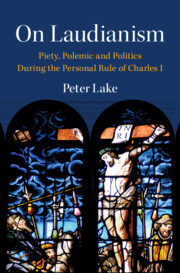Book contents
- On Laudianism
- Cambridge Studies in Early Modern British History
- On Laudianism
- Copyright page
- Contents
- Acknowledgements
- Abbreviations
- Introduction
- Part I Laudianism: Where It Came From
- Part II Laudianism: What It Was
- Part III Laudianism: What It Wasn’t
- Chapter 20 Order, Puritanism and the State of the English Church
- Chapter 21 Puritan ‘Privacy’, or the Forms of Puritan Voluntary Religion Anatomised
- Chapter 22 A Religion of the Word and the Question of Authority
- Chapter 23 Puritanism, Popularity and Politics
- Chapter 24 Of Moderate Puritans and Popular Prelates
- Chapter 25 The Puritan Threat, the Church of England and the Personal Rule as a Period of Reformation
- Part IV Laudianism and Predestination
- Part V Laudianism as Coalition: The Constituent Parts
- Conclusion
- Index
Chapter 25 - The Puritan Threat, the Church of England and the Personal Rule as a Period of Reformation
from Part III - Laudianism: What It Wasn’t
Published online by Cambridge University Press: 05 October 2023
- On Laudianism
- Cambridge Studies in Early Modern British History
- On Laudianism
- Copyright page
- Contents
- Acknowledgements
- Abbreviations
- Introduction
- Part I Laudianism: Where It Came From
- Part II Laudianism: What It Was
- Part III Laudianism: What It Wasn’t
- Chapter 20 Order, Puritanism and the State of the English Church
- Chapter 21 Puritan ‘Privacy’, or the Forms of Puritan Voluntary Religion Anatomised
- Chapter 22 A Religion of the Word and the Question of Authority
- Chapter 23 Puritanism, Popularity and Politics
- Chapter 24 Of Moderate Puritans and Popular Prelates
- Chapter 25 The Puritan Threat, the Church of England and the Personal Rule as a Period of Reformation
- Part IV Laudianism and Predestination
- Part V Laudianism as Coalition: The Constituent Parts
- Conclusion
- Index
Summary
This chapter addresses the paradox, present both in the scholarly literature and in contemporary discourse, where Laudianism was often seen as both a revolutionary and a largely conservative or even reactionary movement; bent on root-and-branch reform and on the preservation of the moderate ‘Anglican’ status quo. This chapter shows that the Laudians presented themselves both as agents of change, pushing for the radical reformation of a church corrupted by decades of puritan corruption, and as conservatives, returning that church to its essential and original condition. What enabled both cases to be made was the extent of puritan influence over, and penetration of, the social and ideological fabric of the church. It was this that necessitated the reformation, which was designed to return the church to the condition it was in before the puritans ‘ruined’ it. That ideal state was variously located in either the Elizabethan or the early Edwardian reformations, and when such precedents were found insufficient to validate certain parts of the Laudian agenda, in the church of the apostles and the fathers. The result was once again a minimum and a maximum case for Laudian reformation, credit for which was variously attributed to Charles I, Archbishop Laud or the bishops more generally construed.
- Type
- Chapter
- Information
- On LaudianismPiety, Polemic and Politics During the Personal Rule of Charles I, pp. 337 - 350Publisher: Cambridge University PressPrint publication year: 2023



